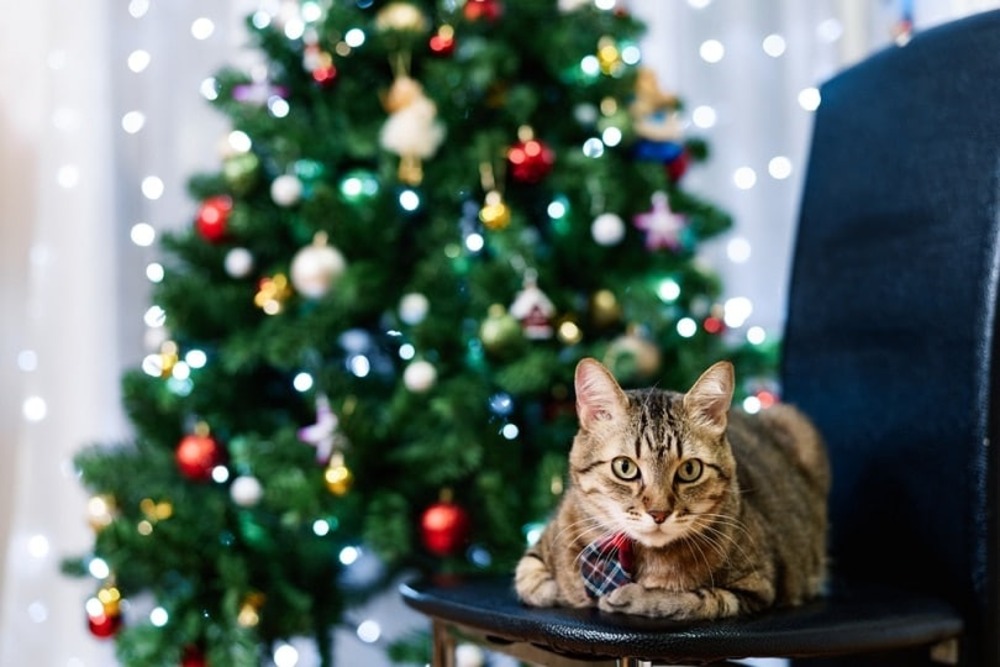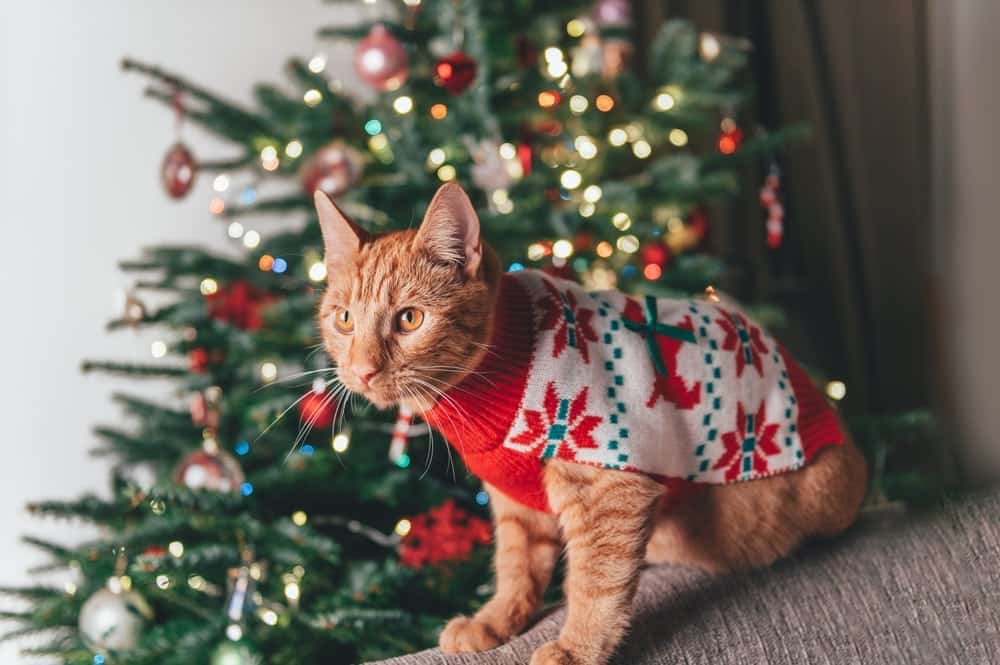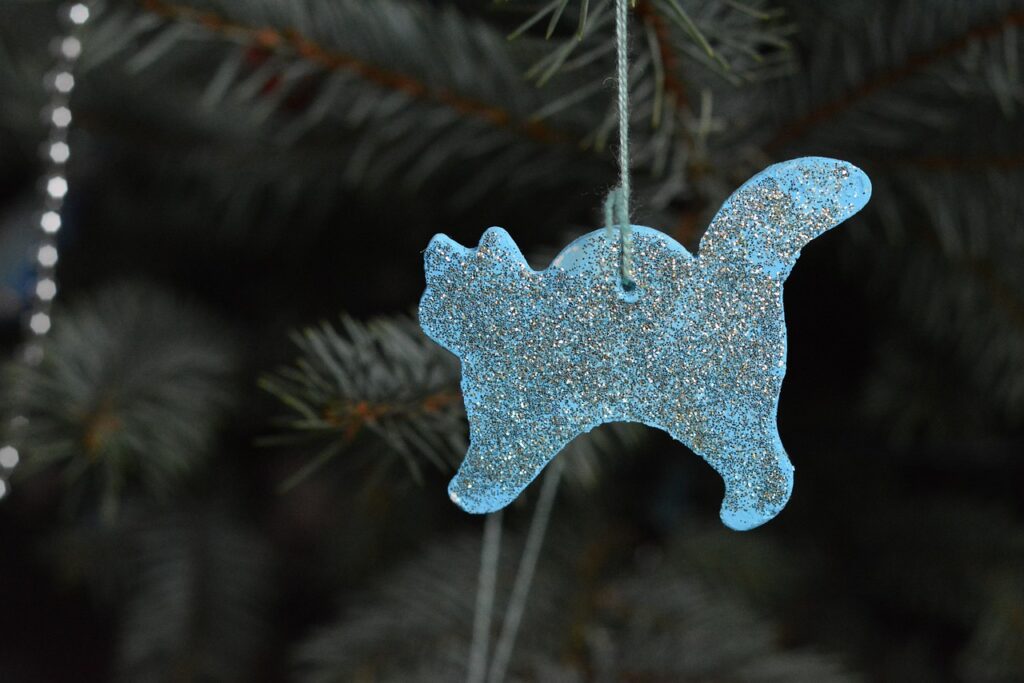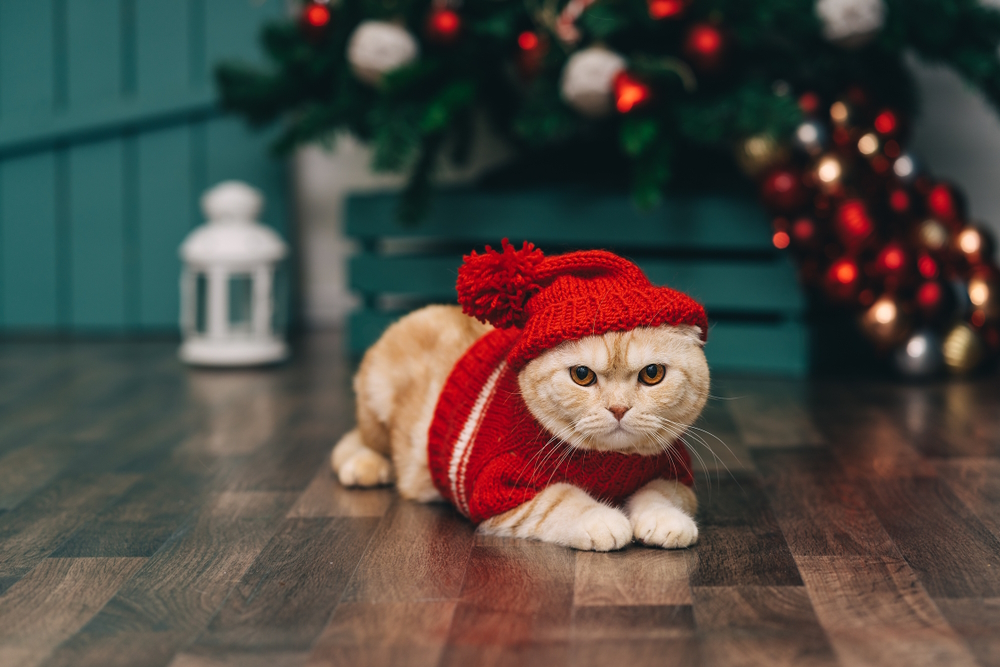Christmas can be quite a taxing time for cat owners. It seems that you’re untangling your cat every few minutes from your Christmas tree decorations. You have to admit, seeing all of those stimulating colors, strings, and pageantry, it’s an exciting time to be a cat in your home.
However, Christmas trees can also pose a danger to our kitties if we’re not careful. So, if you want to keep your cat safe and out of your tree this season, here are 10 things you can try to curb the behavior.
Top 10 Tips to Keep Your Cat Safe Around the Christmas Tree
1. Assess Your Tree
Both artificial and real Christmas trees pose risks for your cat and will often require some intervention from you. The most common types of real Christmas trees (pine, fir, and spruce) have needles that can cause some digestive upset and irritation if they happen to eat a lot of them. Artificial trees, on the other hand, can also be chewed up and swallowed, potentially creating an intestinal blockage.
If your cat has a habit of hovering up items off of the floor (tree needles) you may opt for an artificial tree. If instead your cat likes to chew on things, a real tree may be better since the taste of the real needles may be more off-putting than an artificial tree.

2. Always Unplug the Tree When You Can’t Supervise
Cats may be attracted to Christmas trees for a number of reasons, one of those being the bright lights. While the lights may be beautiful, they can also be dangerous. If a cat were to chew on a string of Christmas lights, they risk being electrocuted. So, if you know you’re not going to be in the room and your cat has made a habit out of playing with the lights, be sure to unplug the tree. This goes for timers as well, be sure that you don’t set the timer to come on when you’re not at home so that your cat always has supervision when the Christmas tree is lit.
3. Reinforce the Tree
Make sure that your tree is steady and secure. You’ll want it to remain standing if your cat tries to scale it. Start by ensuring you have a stable base and consider securing it to the surrounding walls if you have to. Whatever works for your home—it will be different for everyone!

4. Use a Scent Deterrent
There are plenty of cat safe scent deterrents that you can use in your home. You can spray these concoctions around your tree to make your cat think twice about being in a specific area. You can buy formulas at pet shops or online that are explicitly designed for the job.
But, if you choose to go a more natural route, there are several options you can whip up from the comfort of your own home that don’t involve the use of toxic chemicals. Some options include diluted peppermint, lavender, or citrus essential oils.
Make sure your cat cannot come in direct contact with these oils, as they can be very dangerous if ingested or absorbed topically. Also, be sure that the oils are diluted and the room is well ventilated. Speak to your veterinarian if you have any questions about using essential oils around your cat.
You can also try aluminum foil or citrus peels around the base.
5. Don’t Use Glass Ornaments
Glass ornaments can cause all sorts of hazards, from ingestion to physical injury. Plus, if an ornament is very sentimental to you, but your cat can access it, it can get broken as a consequence. The best idea is to put sentimental baubles up in a place where your cats can’t access.
Unfortunately, that means usually not including them on your tree if your cat has access to the area. One swift climb of a tree can cause many ornaments on your tree to shimmy and shake right off, crashing on the floor. Not only is the cleanup a big pain in the butt, but it can injure or hurt your cat.

6. Consider a Protective Barrier
Some folks get creative and implement a productive barrier around their Christmas tree. This helps to stave off their cats a little bit while safeguarding the tree. You can find so many different ideas from around the web, so get creative and use the idea that works best for you. Many people use gates or plant cages around the tree to protect it in all of its integrity.
7. Don’t Let Cats Drink Tree Water
If you have a cut or plantable tree, you will have to water it to keep it fresh. Often, the water is easily accessible to our pets. While they might be drawn to it for various reasons, it can cause gastrointestinal upset if they swallow the water.
Is the water toxic to your cat? It isn’t necessarily that the water itself is toxic, it is more that it is a breeding ground for bacteria. Water can also be filled with preservatives, pesticides, and other agents that leak out from the tree into the water.

8. Limit Room Access
If you can’t be there to supervise, limit your cat’s access in the house. Pick a specific room during the day and have them hang out inside. Don’t make it boring! You can have lots of interactive things for your cat to do while you’re away. However, you’ll want to leave any potentially dangerous decorations or breakable things out.
It might not be so great for your cat to be restricted to certain rooms when you aren’t home to supervise, but it is still completely temporary. The tree will be down soon enough!
9. Don’t Buy Flashing Lights or Tinsel
Flashing Christmas lights might look extremely festive, but to a predator like your cat, they may look like something they want to catch. This can result in electrical shock, property damage, choking hazards, and other issues. Tinsel is also enticing to cats for this reason, and can pose a choking hazard or the possibility for an intestinal obstruction if your cat ingests it.

10. Be Careful Setting Out Poisonous Flowers
Speaking of toxins, lilies and poinsettias are two seasonal, traditional flowers to have around at Christmas time, and many people like to use them around their Christmas tree. As marvelous and beautiful as they are to the naked eye, these plants can be toxic to our cats. While poinsettias can cause digestive issues, eating just a small amount of a lily can quickly lead to kidney failure in your cat. So, if you have a cat that is particularly interested in plants, it’s a good idea to keep them away from any plants that you bring into your home.
Ways to Include Your Cat This Holiday
With the hustle and bustle of the holidays, it’s easy to leave our pets out unintentionally. Some people thrive to make their pet’s experience during the holidays the best possible while others struggle to add them into the equation due to other affairs. If you are looking for ways to incorporate your cat this holiday season, here are some ways you can do that.
1. Get a Stocking
You might already be one step ahead, but you can always give your cat their own stocking for Christmas morning. After all, all the human members of the household have their own, so why not your cat?
2. Buy a Great Gift
Give them a fun interactive gift for Christmas Day. You could try buying a new invention online or coming up with your own DIY project this season. The possibilities are really endless. Keep in consideration your cat’s activity level and preferences to get them something they can safely enjoy for months or even years to come.
3. Include Your Pet for Pictures
Don’t be shy. You could be the family that includes their cat in family pictures. Your fellow cat-loving friends and relatives will love it, and you will have wonderful memories shared with your pet. Everybody wins in this scenario.
Conclusion
Now you know some ways that you can incorporate good tree-keeping practices with a vicious feline terrorizing your holiday home. All of your hard work decorating shouldn’t be all for nothing. You can keep your cat safe from the precious end-of-the-year pageantry with these tips.
But as destructive or menacing as your cat might be this holiday season, remember that there are ways to incorporate them into your seasonal celebration this year.
See also:
- Why Do Cats Love Holiday Decorations So Much? Risks & Precautions
- How to Get Cats to Leave the Christmas Tree Alone: 12 Vet Reviewed Tips
Featured Image Credit: tickcharoen04, Shutterstock
Contents
- Top 10 Tips to Keep Your Cat Safe Around the Christmas Tree
- 1. Assess Your Tree
- 2. Always Unplug the Tree When You Can’t Supervise
- 3. Reinforce the Tree
- 4. Use a Scent Deterrent
- 5. Don’t Use Glass Ornaments
- 6. Consider a Protective Barrier
- 7. Don’t Let Cats Drink Tree Water
- 8. Limit Room Access
- 9. Don’t Buy Flashing Lights or Tinsel
- 10. Be Careful Setting Out Poisonous Flowers
- Ways to Include Your Cat This Holiday
- Conclusion












